Study on Deformation Characteristics of Surrounding Rock of Roadway with Coal–Rock Interface
Abstract
:1. Introduction
2. Roadway Model and Analysis
2.1. Stress and Deformation of Roadway
- (1)
- The displacement and deformation of the sidewalls without coal–rock interface are large in the middle and small at both ends. The lateral deformation of the contact position between the roadway side and the top and bottom is very small, and the lateral displacement of the contact position between the top and bottom is smaller than that of the contact position between the top and bottom. The free faces of both sides of the roadway protrude in the roadway, due to the lack of connection constraints between roof and wall in the roadway with coal–rock interface. The lateral displacement of the upper part of the roadway wall in contact with the roof is the largest; it decreases slightly downward, and the contact with the floor is the smallest.
- (2)
- The displacement of both sides of the roadway is positively correlated with the increase of burial depth. The greater the burial depth is, the greater the deformation of the roadway is. With the increase of burial depth, the displacement of the middle part of the side of the roadway with coal–rock interface gradually increases. Except for the small displacement of the measuring points at the contact with the floor, the displacement of the other measuring points has little difference. In addition, the floor heave occurs during the loading process of the roadway, and the roadway presents the deformation characteristics of the whole side extruding toward the interior of the roadway.
- (3)
- When the buried depth of the roadway is 300 m, the maximum deformation of the wall of the roadway without coal–rock interface is 1.11 cm and the maximum deformation of the wall of the roadway with coal–rock interface is 2.2 cm. When the buried depth is 550 m, the maximum deformation is 2.29 cm and 3.85 cm, respectively, with a difference of 1.56 cm, which is 1.68 times the deformation of the roadway without the interface model.
- (1)
- With or without coal–rock interface, the deformation form of the roadway roof and floor is basically the same. The roof is bulged with a “sag” deformation in the middle, and the bulged “extrusion” deformation in the middle of the floor. The displacement of the roadway roof and the middle of the floor is the largest, and the deformation on both sides is very small.
- (2)
- With the increase of buried depth, the roof and floor deformations of the two roadways increase gradually. When the burial depth is 300 m, the maximum deformation of the roof of the roadway without coal–rock interface is 0.64 cm, the maximum deformation of the floor is 1.13 cm, the maximum deformation of the roof of the roadway with coal–rock interface is 0.09 cm and the maximum deformation of the floor is 1.198 cm. When the buried depth is 550 m, the maximum deformation of the roof of the roadway without coal–rock interface reaches 25.1 cm, and the maximum deformation of the floor is 2.51 cm, which is 1 cm larger than that of the roadway with coal–rock interface.
2.2. Influence of Interface on Tunnel Deformation and Instability
- (1)
- At the same burial depth, the maximum deformation of the roof, floor and side of the roadway with coal–rock interface between the coal seam and roof is greater than that of the roadway without coal–rock interface.
- (2)
- The increasing range of the maximum deformation of the wall and roof decreases with the increase of the burial depth. The wall deformation of the roadway with interface is larger than that of the roadway without interface, which is equivalent to increasing the span of the roadway roof and the roof deformation. The maximum deformation of the floor increases with the increase of the buried depth.
- (3)
- It can be seen from the deformation nephogram that the coal pillar at the deformed side of the roadway without coal–rock interface is well-connected with the roof, and there is no mutual slip and dislocation. However, the slip and dislocation between the coal pillar and the roof at the deformed side of the roadway with coal–rock interface is evident. When the burial depth is large, the side appears to extrude into the roadway as a whole. The roadway forms a triangle extrusion area on the floor, the floor heave range is larger, the floor enters the plastic state prematurely and the maximum deformation of the floor continues to increase.
3. Interface Stiffness and Position
3.1. Interface Stiffness
- (1)
- Under different ks values, the surrounding rock stress of the roof, floor and side of roadway decreases first from shallow to deep, then reaches the peak and finally decreases to the original rock stress.
- (2)
- Near the top of roadway, the smaller the interface stiffness, the lower the stress value. With the increase of the shear stiffness of the interface, the peak stress of the roadway roof and both sides increases first, and then tends to be flat. The distance between the peak point of the roof and the top of roadway gradually shrinks, and the distance between the peak point of wall and the side of roadway is approximately 1.5 m~2.0 m.
- (3)
- With the increase of the shear stiffness of the interface, the peak stress of the roadway floor decreases gradually, and the peak point is gradually closer to the roadway bottom. The statistics of peak stress and concentration factor of roadway surrounding rock are shown in Table 2.
3.2. Interface Position
- (1)
- When the coal–rock interface is 3 m from the roadway floor and is a full seam roadway, the deformation is relatively continuous, and the deformation gradually decreases from the interface to the bottom of the roadway wall. When the coal–rock interface is between the roof and floor of the roadway, the deformation of the rock part of the slope and the coal part has obvious differences. The deformation is discontinuous at the interface, and there is dislocation between the rock stratum and the coal seam.
- (2)
- The larger the proportion of rock in the roadway side, that is, the smaller the value of a, the greater the deformation of rock in the roadway side. On the contrary, the deformation of coal body increases. When a is no less than 1.5 m, the deformation of rock is less than that of the coal body, and the slope is slightly bulged. When the a value is 0.5 m, the deformation of rock mass is greater than that of coal.
- (3)
- The interface position has little influence on the deformation of the roadway floor, the maximum deformation value is 0.0162 m~0.0166 m and the deformation shape is basically consistent. As the interface is further away from the roadway floor, that is, the greater the value of a, the deformation of the floor slightly increases, and the deformation of the roof gradually increases, with the maximum deformation between 0.006 m and 0.0114 m. The roof deformation is concave, with the largest deformation in the middle and gradually decreasing toward both ends.
4. Discussion
5. Conclusions
- (1)
- The stress distribution and deformation of the roadway are closely related to the interface between the coal and rock strata. When there is a coal–rock interface, the vertical stress-concentration area of the sidewall is closer to the floor corner. The slip and dislocation between the coal sidewall and the roof are obvious. The roadway forms a triangular compression area on the floor, and the floor enters the plastic state prematurely. The lateral displacement at the contact between the sidewall and roof is the largest and gradually decreases downward. With the increase of the buried depth, the deformation of the roadway increases gradually, and the difference between the two increases gradually. The maximum wall deformation of coal–rock interface roadway is 1.68 times that of the non-interface roadway.
- (2)
- With the increase of interface stiffness, the displacement of side, floor and roof decreases obviously. The shear stiffness of the coal–rock interface is 5 GPa·m−1, which is the critical value. When the shear stiffness of the interface is less than 5 GPa·m−1, the displacement of the sidewall decreases in a linear form with the increase of the strength of the coal–rock interface. When the stiffness is greater than 5 GPa·m−1, the trend of the displacement reduction decreases.
- (3)
- The stress and deformation patterns of the tunnel vary with the location of the interface in the tunnel. When it is a full coal roadway, the deformation decreases gradually from the interface to the floor. When the coal–rock interface is between the roadway roof and floor, the slope is discontinuous deformation, and there is dislocation between the rock stratum and the coal seam. When the coal height is not less than 1/2 of the roadway height, the rock deformation is less than the coal body. When the coal height is 0.5 m, the rock deformation is greater than the coal.
- (4)
- The reason for this deformation of the roadway is that the lateral deformation of the coal sidewall is greater than that of the rock. When the pressure is the same, the lateral deformation of the coal body is greater, and the peak strength of the coal is low. The plastic deformation occurs first, and the plastic deformation makes the coal body have a greater lateral deformation, forming the macro cracks. Therefore, the coal seams and rock strata can be connected to limit the overall lateral movement of the coal body at the side of the roadway by enhancing the bond and friction strength of the rock stratum and the coal seam bedding surface, or by means of cross-layer anchoring.
Author Contributions
Funding
Institutional Review Board Statement
Informed Consent Statement
Data Availability Statement
Acknowledgments
Conflicts of Interest
References
- Chen, G.; Li, T.; Yang, L.; Zhang, G.; Li, J.; Dong, H. Mechanical properties and failure mechanism of combined bodies with different coal–rock ratios and combinations. J. Min. Strat. Control Eng. 2021, 3, 023522. [Google Scholar] [CrossRef]
- Chen, W.; Wan, W.; Zhao, Y.; Peng, W. Experimental Study of the Crack Predominance of Rock-Like Material Containing Parallel Double Fissures under Uniaxial Compression. Sustainability 2020, 12, 5188. [Google Scholar] [CrossRef]
- Yu, W.; Wu, G.; Liu, H.; Wang, P.; An, B.; Liu, Z.; Huang, Z.; Liu, F. Deformation characteristics and stability control of soft coal -rock mining roadway in thin coal seam. J. China Coal Soc. 2018, 43, 2668–2678. [Google Scholar] [CrossRef]
- Zhao, Z.; Lv, X.; Wang, W.; Tan, Y. Damage evolution of bi-body model composed of weakly cemented soft rock and coal considering different interface effect. Springer Plus 2016, 5, 292–311. [Google Scholar] [CrossRef] [Green Version]
- Zuo, J.; Chen, Y.; Cui, F. Investigation on mechanical properties and rock burst tendency of different coal -rock combined bodies. J. China Univ. Min. Technol. 2018, 47, 81–87. [Google Scholar] [CrossRef]
- Yin, D.; Chen, S.; Sun, X.; Jiang, N. Strength Characteristics of Roof Rock-Coal Composite Samples with Different Height Ratios Under Uniaxial Loading. Arch. Min. Sci. 2019, 64, 307–319. [Google Scholar] [CrossRef]
- Zhao, P.; He, Y.; Li, S.; Lin, H.; Jia, Y.; Yang, E. Coal thickness effect on mechanics and energy characteristics of coal–rock combination model. J. Min. Saf. Eng. 2020, 37, 1067–1076. [Google Scholar] [CrossRef]
- Cao, J.; Dai, Q.; Zhou, Y.; Ma, D. Failure mechanism and strength of coal–rock combination bodies considering dip angles and fractal characteristics of interface. J. Cent. South Univ. (Sci. Technol.) 2018, 49, 175–182. [Google Scholar] [CrossRef]
- Tian, C.; Sun, H.; Dai, L.; Li, R.; Wang, B.; Cao, J.; Wang, J.; Hu, Q. Experimental study on mechanical properties and energy evolution law of coal–rock composite structure under different interface connection modes. Geofluids 2022, 2022, 1288463. [Google Scholar] [CrossRef]
- Liu, X.S.; Tan, Y.L.; Ning, J.G.; Lu, Y.W.; Gu, Q.H. Mechanical properties and damage constitutive model of coal in coal–rock combined body. Int. J. Rock Mech. Min. Sci. 2018, 110, 140–150. [Google Scholar] [CrossRef]
- Zhao, Z.; Wang, W.; Wang, L.; Dai, C. Compression-shear strength criterion of coal–rock combination model considering interface effect. Tunn. Undergr. Space Technol. 2015, 47, 193–199. [Google Scholar] [CrossRef]
- Wang, M.; Xiao, T.; Gao, J.; Liu, J. Deformation mechanism and control technology for semi coal and rock roadway with structural plane under shearing force. J. Min. Saf. Eng. 2017, 34, 527–534. [Google Scholar] [CrossRef]
- Jin, G.; Wang, L.; Zhang, J. Failure characteristics and support technology for deep half coal–rock mining roadway. Saf. Coal Mines 2015, 46, 126–129. [Google Scholar] [CrossRef]
- Zhao, T.; Guo, W.; Lu, C.; Zhao, G. Failure characteristics of combined coal–rock with different interfacial angles. Geomech. Eng. 2017, 11, 345–359. [Google Scholar] [CrossRef]
- Chang, B.; Liu, X.; Jia, C.; Yan, R. Study on deformation characteristics and deformation mechanism of steep coal rock interbedded roadway. Coal Sci. Technol. 2022, 50, 40–49. [Google Scholar] [CrossRef]
- Yang, X.; Sun, D.; Jing, H. Morphological features of shear-formed fractures developed in a rock bridge. Eng. Geol. 2020, 278, 105833. [Google Scholar] [CrossRef]
- Yu, W.; Wu, G.; Liu, Z.; Huang, Z.; Liu, F.; Ren, H. Uniaxial compression test of coal–rock-bolt anchorage body and mechanical mechanisms of bolts. Chin. J. Rock Mech. Eng. 2020, 39, 57–68. [Google Scholar] [CrossRef]
- Li, W.; Bai, J.; Cheng, J.; Peng, S.; Liu, H. Determination of coal–rock interface strength by laboratory direct shear tests under constant normal load. Int. J. Rock Mech. Min. Sci. 2015, 60–67, 1063–1070. [Google Scholar] [CrossRef]
- Liu, Y.; Lu, C.; Xiao, Z.; Guo, Y. Mechanisms Underlying the Slip and Failure of coal–rock Parting-Coal Structures Under Unloading Conditions. Rock Mech. Rock Eng. 2022, 55, 4913–4928. [Google Scholar] [CrossRef]
- Jin, G.; Wang, L.; Li, Z.; Zhang, J. Study on the gateway rock failure mechanism and supporting practice of half-coal–rock extraction roadway in deep coal mine. J. Min. Saf. Eng. 2015, 32, 963–967. [Google Scholar] [CrossRef]
- Chen, Y.; Liu, H.-L. Development and implementation of Duncan-Chang constitutive model in FLAC3D. Rock Soil Mech. 2007, 28, 2123–2126. [Google Scholar] [CrossRef]

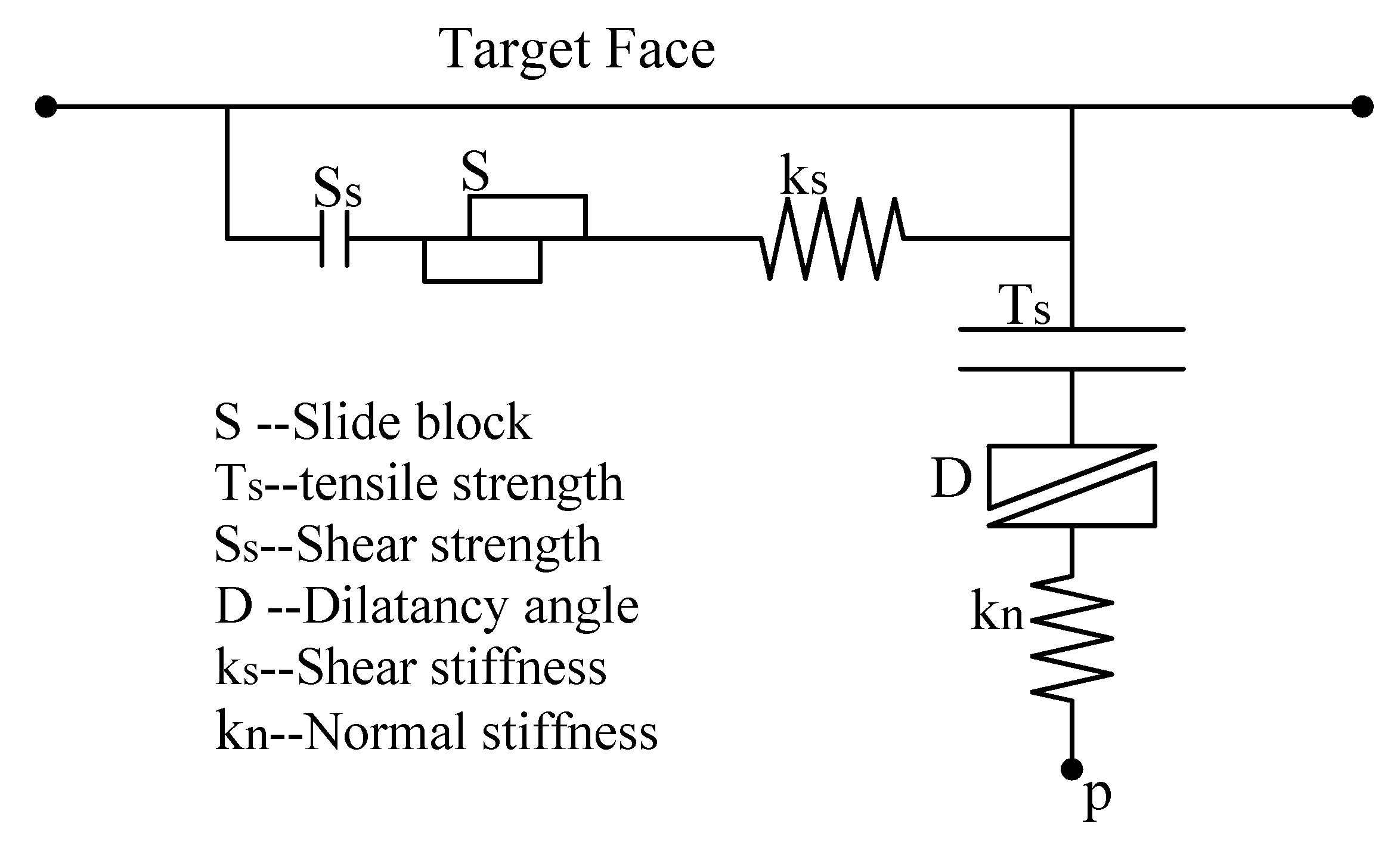

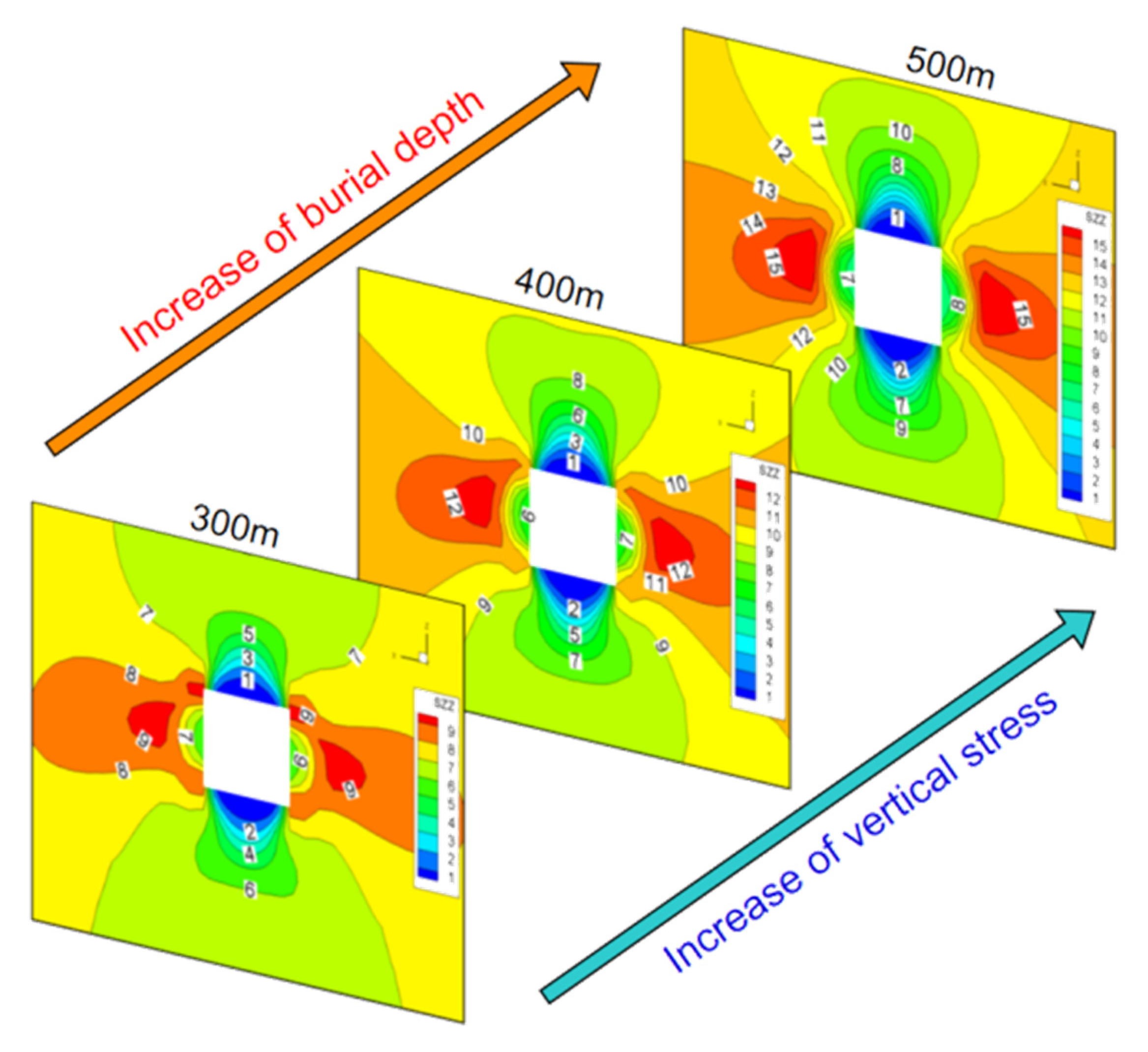

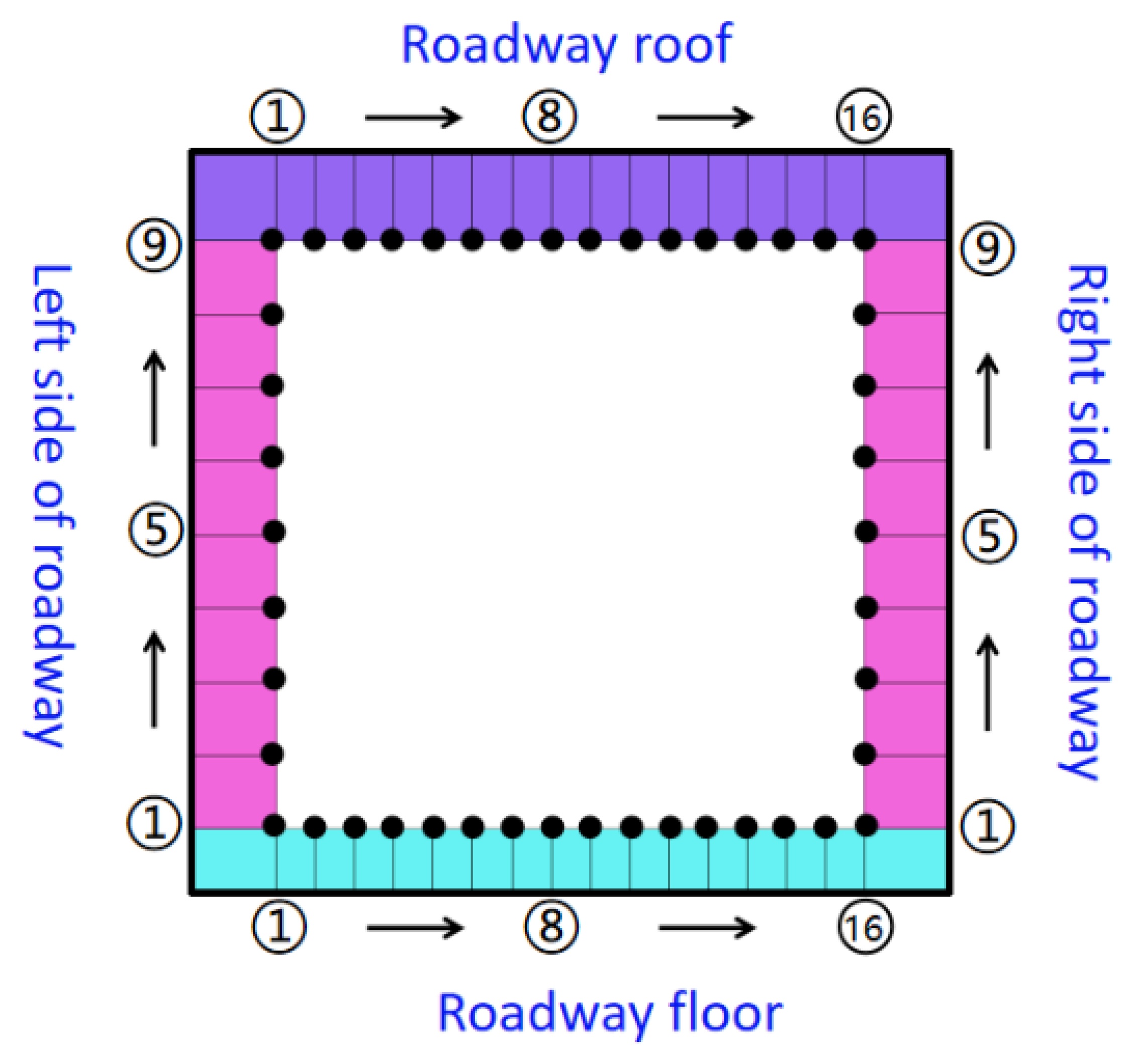
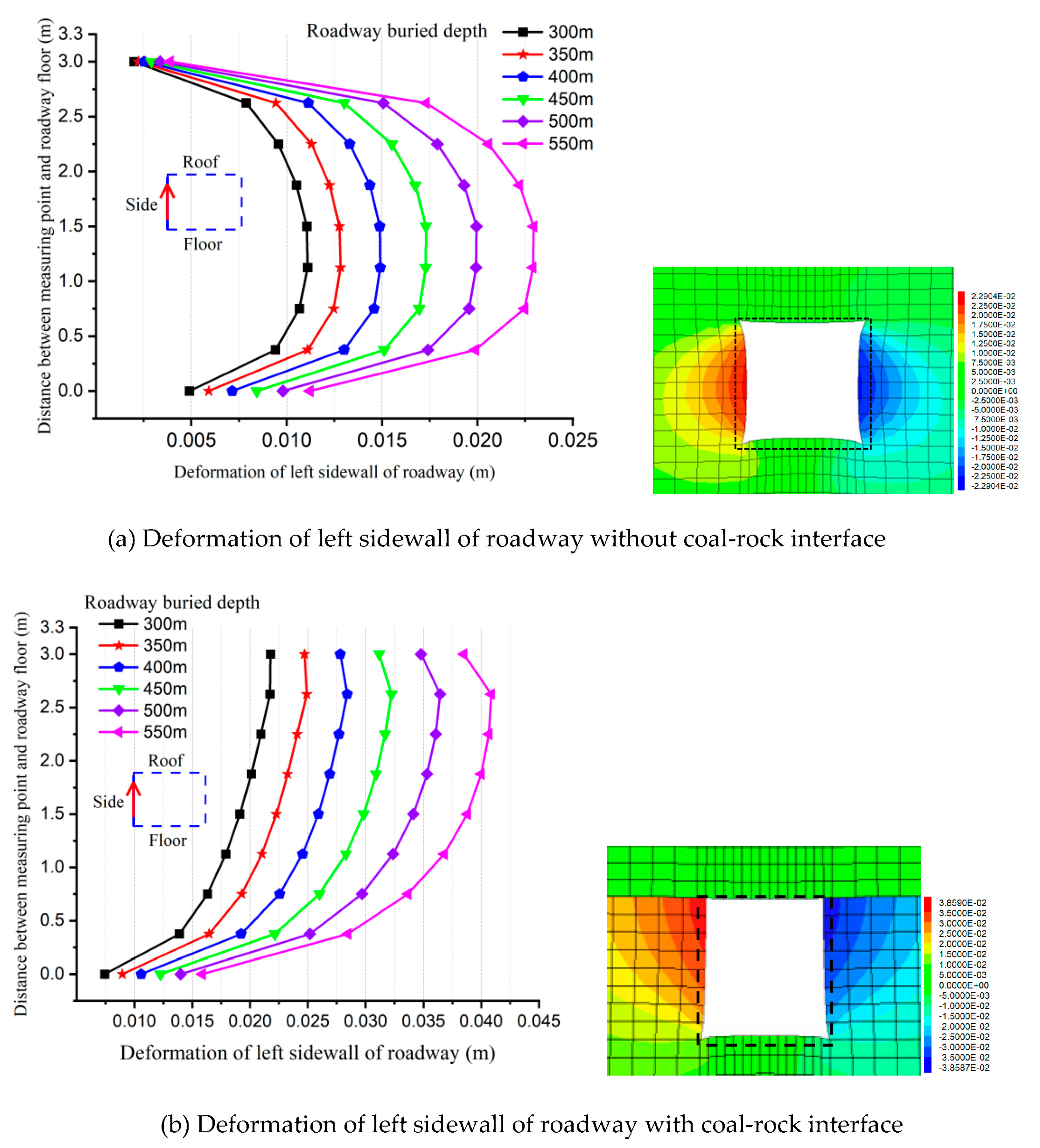
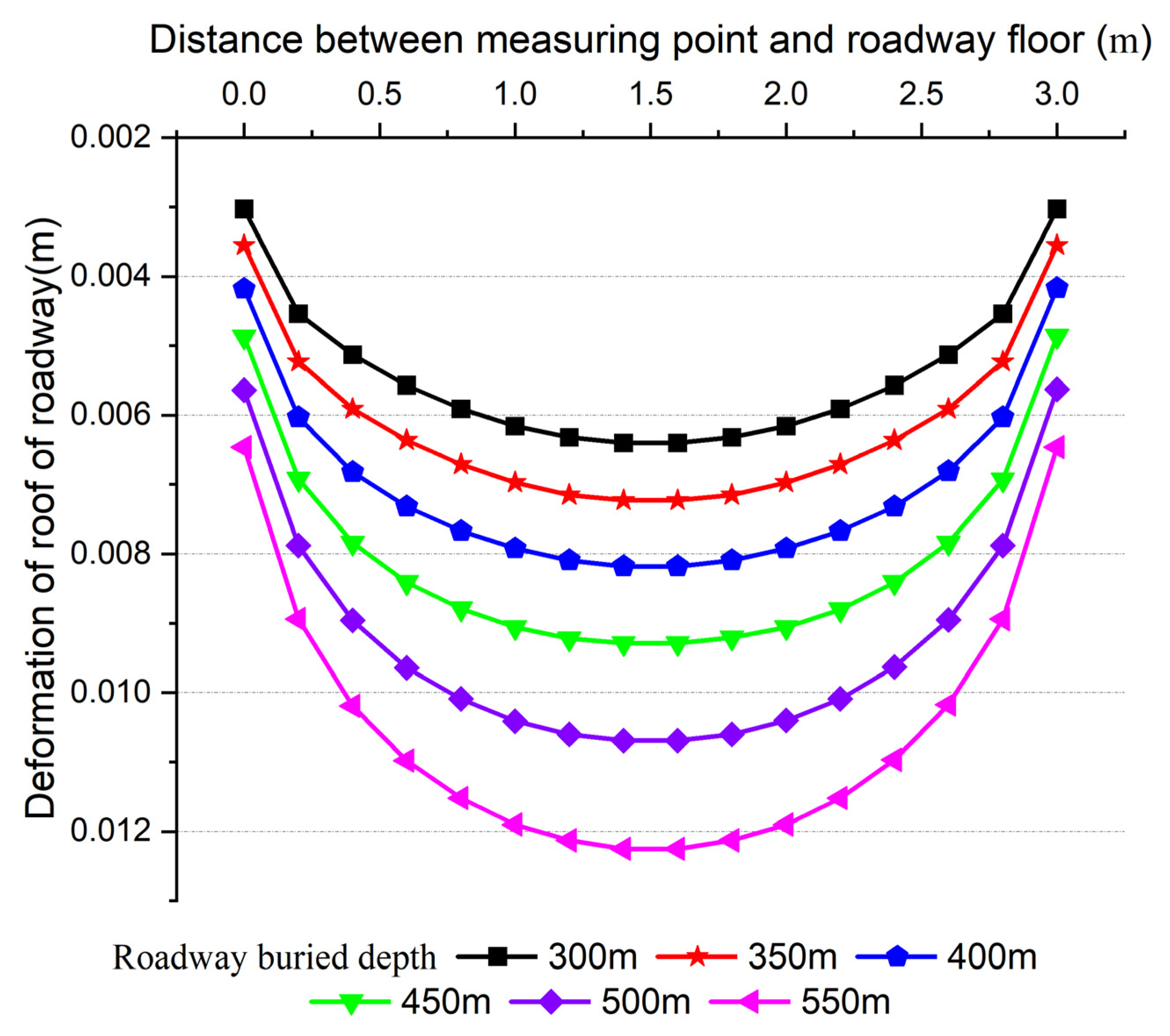
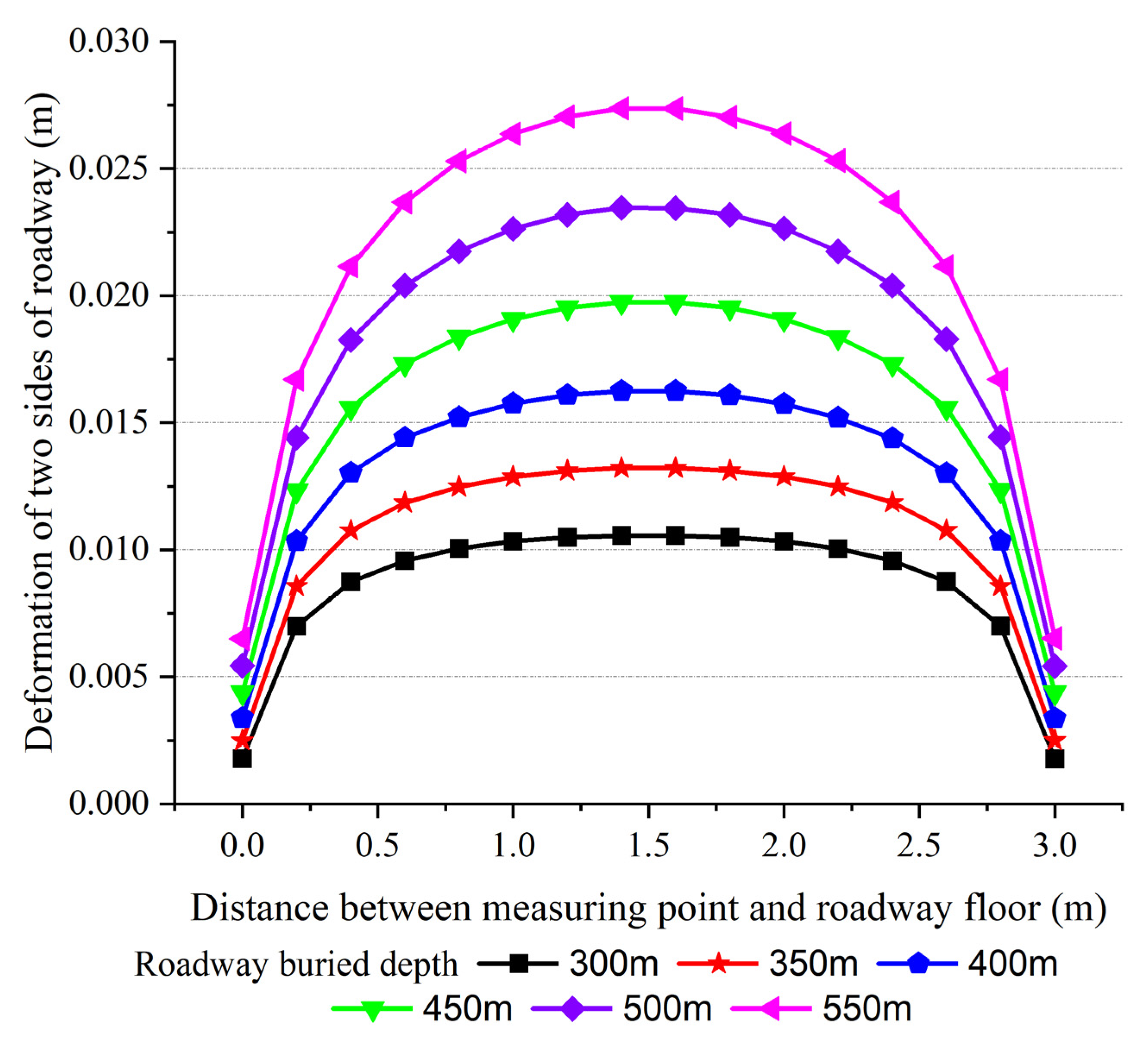

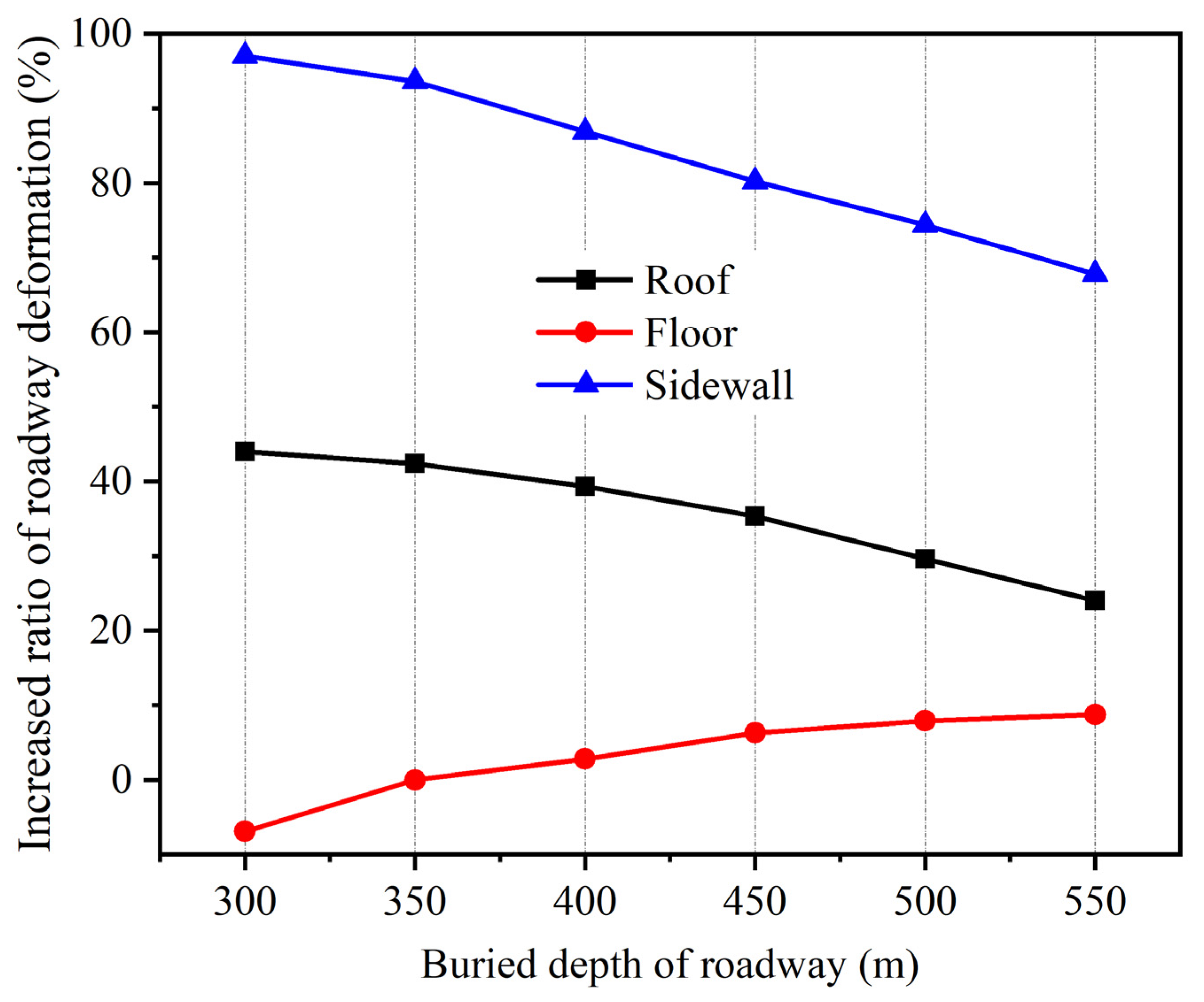

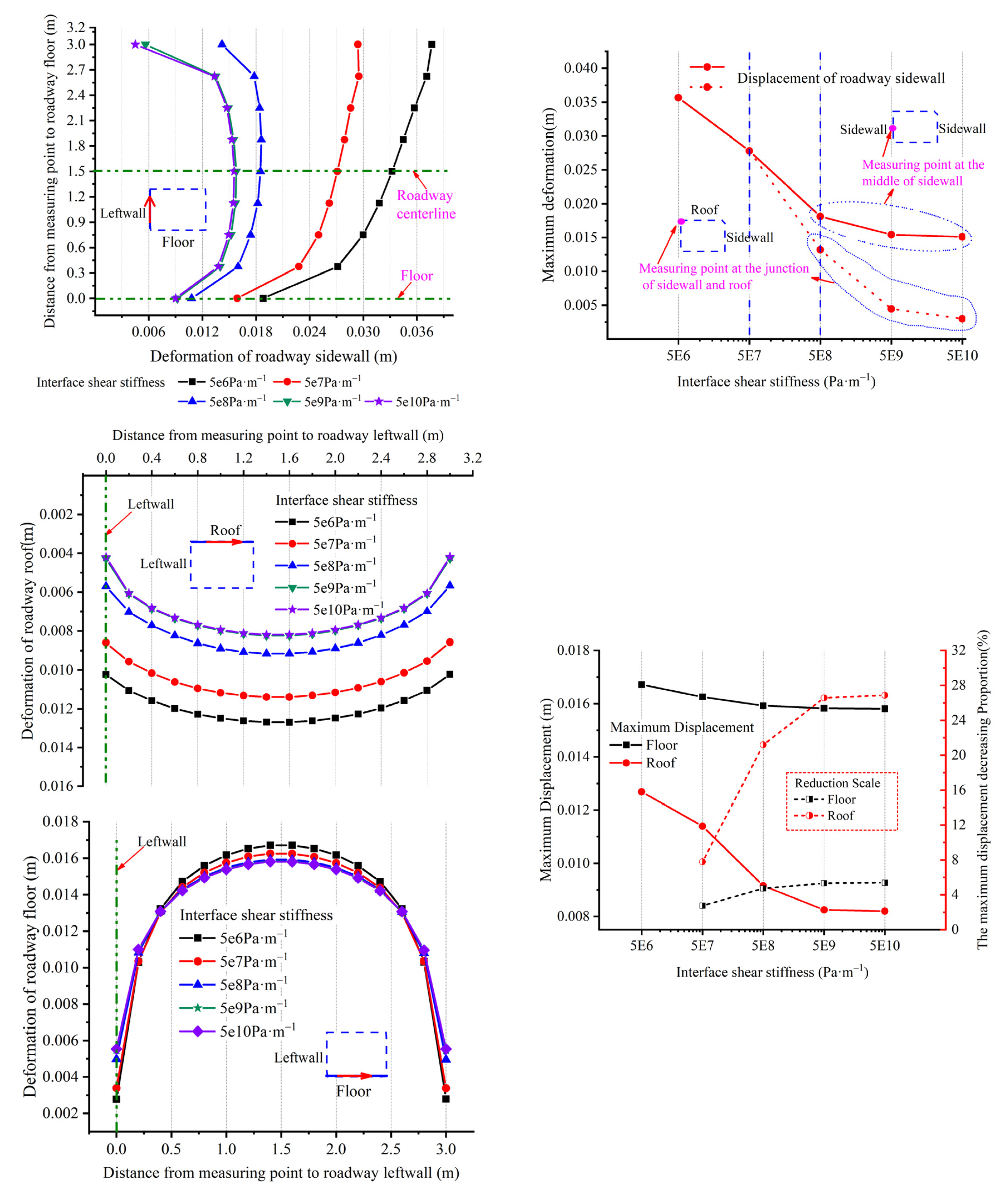

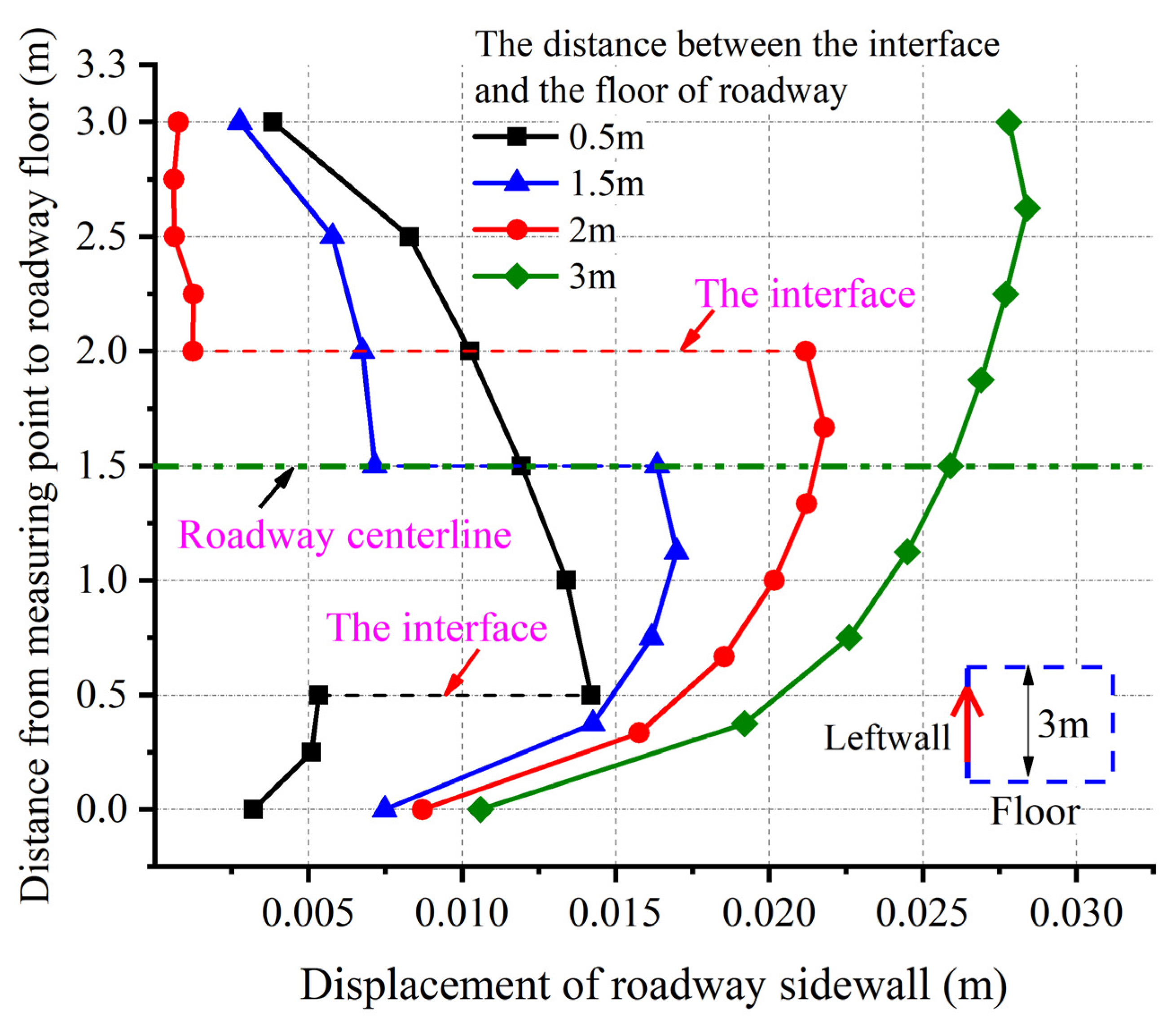
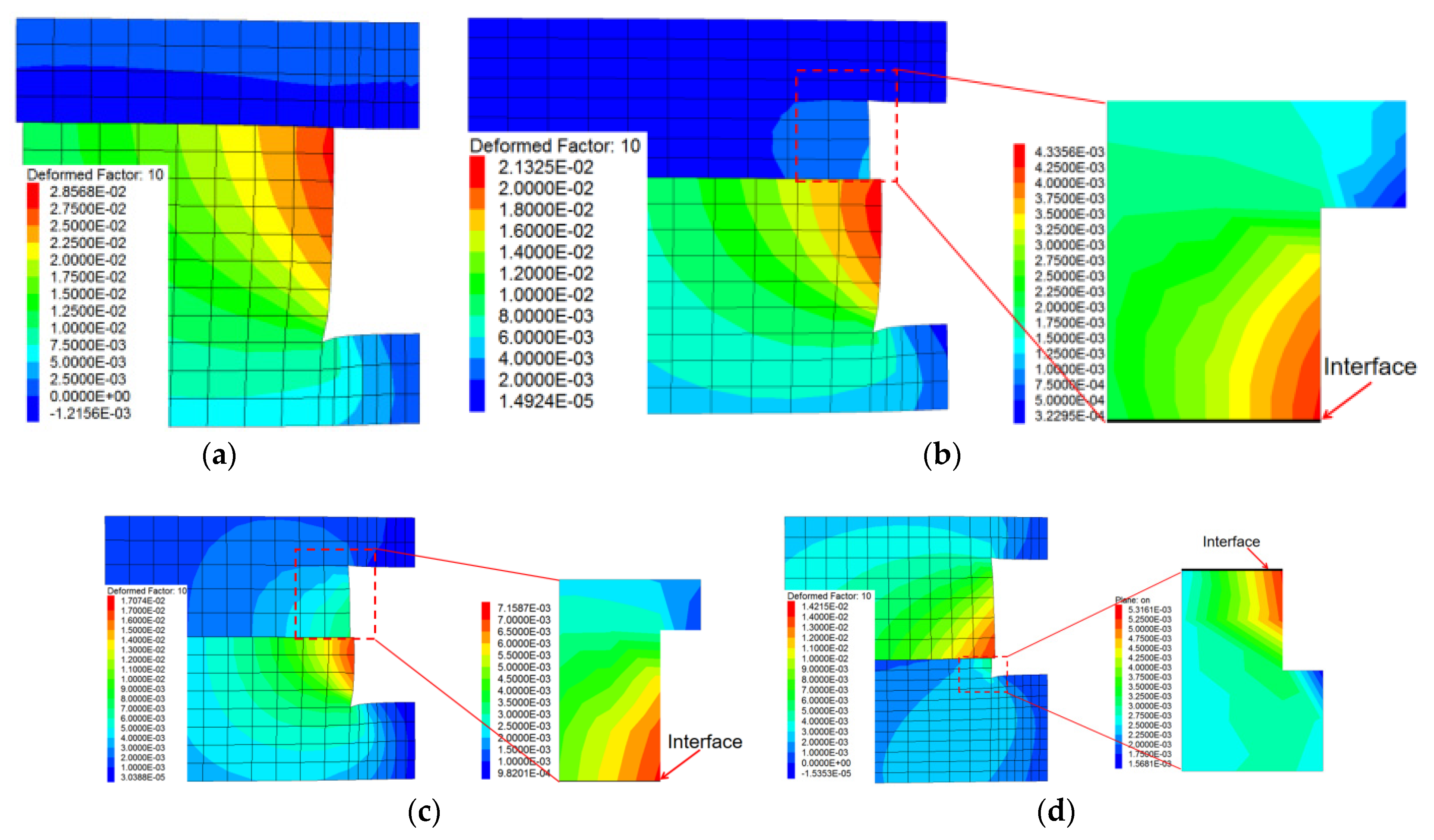

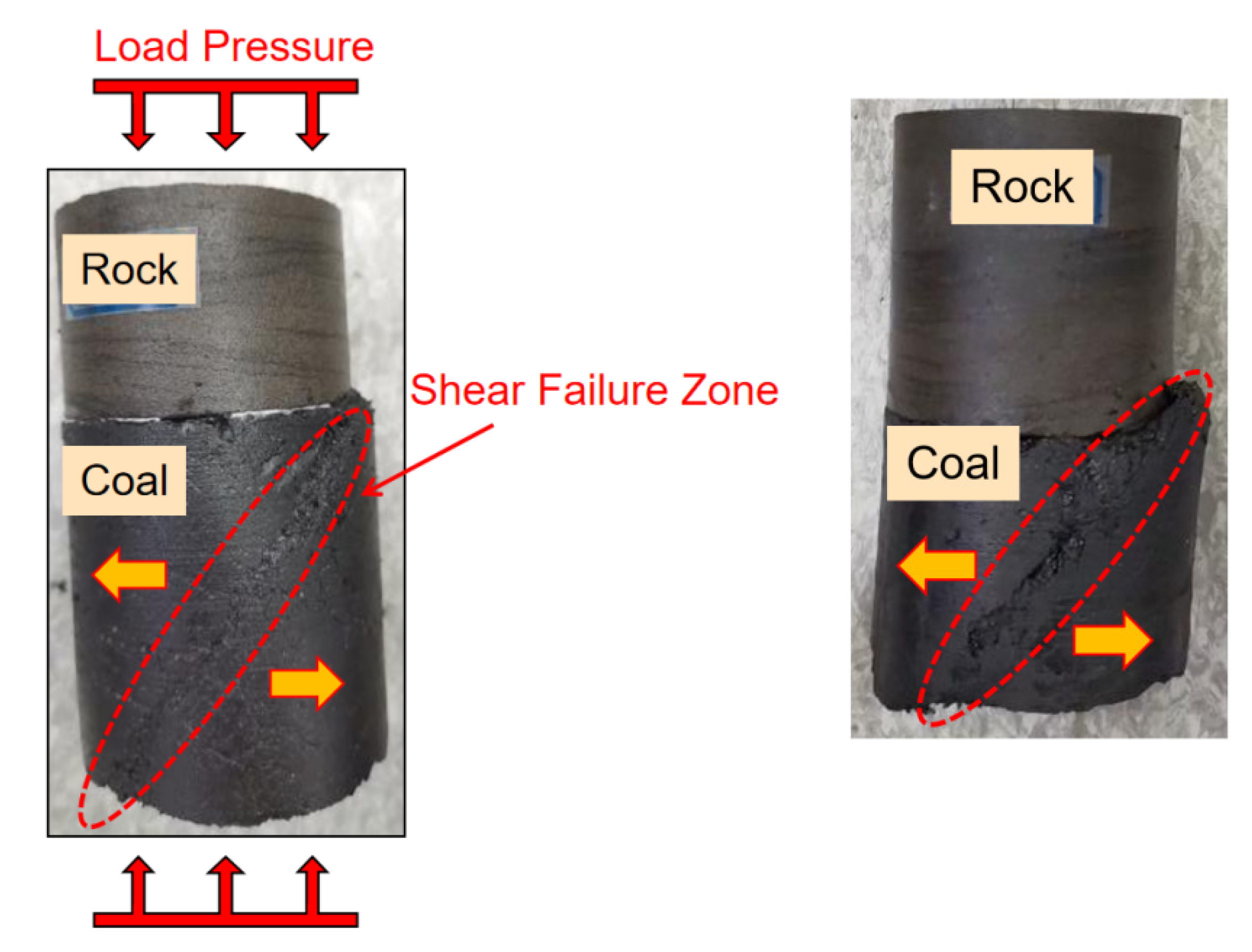
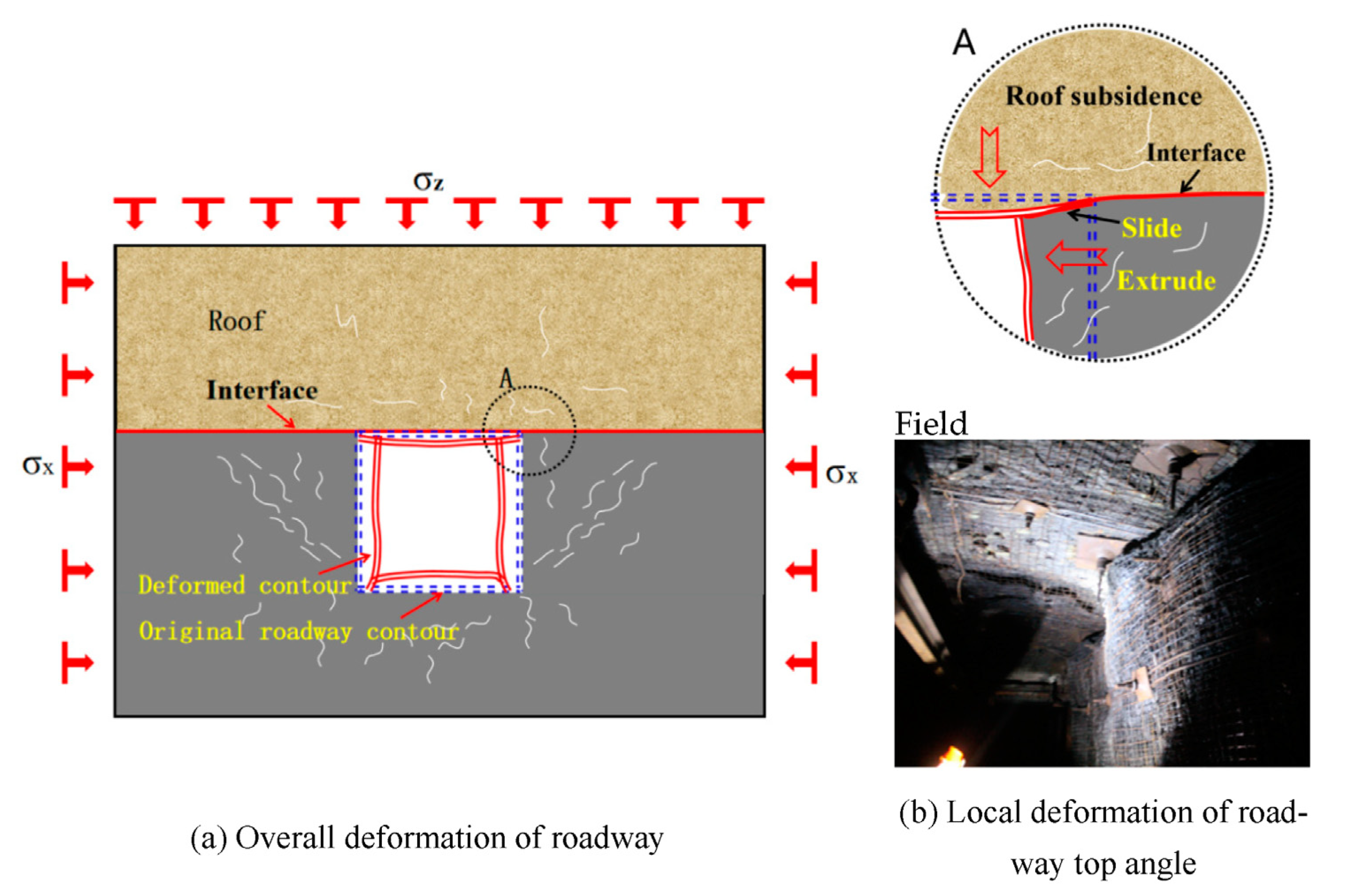
| Composite Rock Mass | E/GPa | v | /° | c/MPa | Layer Thickness/m |
|---|---|---|---|---|---|
| Fine sandstone | 9.57 | 0.25 | 30 | 3.12 | 5 |
| Medium sandstone | 7.73 | 0.25 | 30 | 2.86 | 15 |
| Mudstone | 6.88 | 0.28 | 35 | 2.12 | 7 |
| Coal | 1.22 | 0.33 | 8 | 1.43 | 6 |
| Mudstone | 6.88 | 0.28 | 35 | 2.12 | 5 |
| Fine sandstone | 9.57 | 0.25 | 30 | 3.12 | 12 |
| Medium sandstone | 7.73 | 0.25 | 30 | 2.86 | 5 |
| Peak Tress/MPa Factor of Stress Concentration | ks/Pa·m−1 | ||||
|---|---|---|---|---|---|
| 5 × 106 | 5 × 107 | 5 × 108 | 5 × 109 | 5 × 1010 | |
| Peak stress in horizontal direction | 15.63 | 15.16 | 13.87 | 13.40 | 13.53 |
| Factor of stress concentration | 1.56 | 1.52 | 1.39 | 1.34 | 1.35 |
| Peak stress in vertical direction | 11.96 | 12.02 | 12.29 | 12.76 | 12.86 |
| Factor of stress concentration | 1.20 | 1.20 | 1.23 | 1.28 | 1.29 |
Disclaimer/Publisher’s Note: The statements, opinions and data contained in all publications are solely those of the individual author(s) and contributor(s) and not of MDPI and/or the editor(s). MDPI and/or the editor(s) disclaim responsibility for any injury to people or property resulting from any ideas, methods, instructions or products referred to in the content. |
© 2023 by the authors. Licensee MDPI, Basel, Switzerland. This article is an open access article distributed under the terms and conditions of the Creative Commons Attribution (CC BY) license (https://creativecommons.org/licenses/by/4.0/).
Share and Cite
Wang, T.; Chang, J.; Guo, Y. Study on Deformation Characteristics of Surrounding Rock of Roadway with Coal–Rock Interface. Sustainability 2023, 15, 5347. https://doi.org/10.3390/su15065347
Wang T, Chang J, Guo Y. Study on Deformation Characteristics of Surrounding Rock of Roadway with Coal–Rock Interface. Sustainability. 2023; 15(6):5347. https://doi.org/10.3390/su15065347
Chicago/Turabian StyleWang, Tuo, Jucai Chang, and Yijun Guo. 2023. "Study on Deformation Characteristics of Surrounding Rock of Roadway with Coal–Rock Interface" Sustainability 15, no. 6: 5347. https://doi.org/10.3390/su15065347






